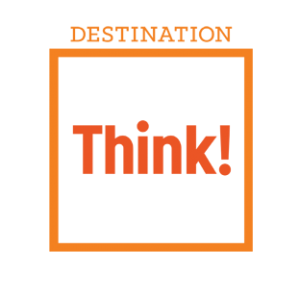» Next Entries
Category
Internet
-
Internet
Picture this
A large room full of people in a conference, say about 1000. About 100 are talking to each other, the rest are all typing on their cell phones, or on a laptop, mostly powerbooks.
People either dressed in suits (sometimes with bright coloured sneakers) or in jeans and t-shirts, or some hipster outfit including haircut (hey, that’s me).
Billions of dollars in wealth fiddling around with laptops to get them hooked up to the projector.
5,000 unfilled requests to attend the “summit”
One guy from Vancouver; me, I checked the attendee list (but there is somebody from Burnaby though)
…and you have the web 2.0 summit -
Internet
The Net Generation
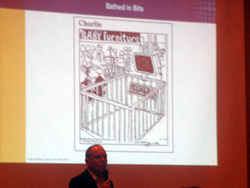
The best session so far. Don Tapscott (he’s Canadian eh?) gave a fascinating presentation about how young people grow up and how technology is part of their lives without really realizing that it’s there, just like breathing. I have to look at my notes for more insights but I’m encouraged that this perception of the bad teenager looking at all the wrong places online, or the bad teenagers wasting their time playing games, surfing the internet and lacking social skills is conventional wisdom. Great stuff, I even recognize some of my own behaviour in his research. -
Internet
Yahoo’s Web 2.0 Strategy
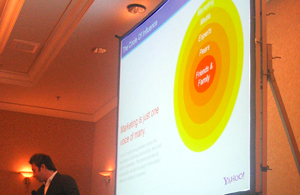
The first workshop at Web 2.0 is in a packed room (I’m sitting on the floor, I was a bit late and the session is still going). The learning is great. How to use your online community to increase value to users, publishers and advertisers by leveraging the tail. Exactly what we’re talking about on a smaller scale. It’s all about the community and giving them enough power and the tools to manage themselves. Marketing is just one voice of many (see photo), and marketers have to realize this and leverage it.
Web 1.0 – everything happens on my site
Web 2.0 – let’s open ourselves up to create communities on their terms and let us provide the platform -
Internet, personal
Agency.com’s Subway Pitch
It’s always interesting to find out what happened online and/or in the blogosphere when I come back from vacation. One of the first things I noticed was the commotion around the agency.com Subway pitch.
As part of a Request For Information from Subway, agency.com created a video and tried to demonstrate their online marketing abilities by demonstrating their viral marketing by posting the video and outtakes on YouTube. The blogosphere exploded immediately. In particular advertising related blogs. And the opinions weren’t pretty. Other advertising professionals are mostly commenting on the quality of creative, whether or not it is considered viral marketing, the looks and behaviour of the people included in the video and the language they use. “When we roll, we roll big” will probably become part of (at least agency) vocabulary and agency.com smartly put more oil on the fire by starting a blog called whenwerollwerollbig.com.
I happen to be somebody who works client-side so I’m going to weight in from my perspective. No, I didn’t like the video either when I saw it. It wasn’t funny, full of buzz words and some of the “big ideas” and meetings reminded me of bad episodes of “the Apprentice”. The comment about the salary of subway employees was offensive and should have been edited out. But beside the salary comment, none of all this matters. Results matter.
And I recognize the results. The video has been watched over 80,000 times so far and everybody is talking about it. So they’ve successfully proven that they understand online marketing, viral or not. When I talk to my peers outside Tourism BC, the frustration I hear the most is “our agency doesn’t understand online marketing“, right before “our marketing department doesn’t understand the User Experience“. The two are related because the latter select the former. And for the record, I consider myself more fortunate then most of my peers. If Agency.com can produce this kind of reaction for this purpose, they might just be able do it for a consumer campaign as well. At least I would give them the benefit of the doubt for whatever the next step in the process is.
Here’s the video:
Update 8/25: Just found out Agency.com pulled out of the running. My guess is that a higher-up pulled the plug because of the negative backlash. We’ll never know what Subway thought of the whole thing.
-
Internet
Using Google Trends
07.17.06 | Permalink | 2 CommentsGoogle Trends is a pretty cool tool for the online marketer’s toolkit. It allows you to trend search keywords over the last few years, by country. For North America, it will also try to corelate the news to search volume, although it’s not doing a very good job at the moment. Here’s one example of how I would use it:
When do people start planning ski vacations?
When is the right time to start marketing skiing? And does it differ by country? Let’s see if Google trends can give us the answer.United States

The graph above the time scale indicates the number of searches for the keyword “Whistler” and “Vail”. The graph below the time-line shows the number of references in new sites. You can see that both resorts are searched year-round but things start to spike in early October. Perfect time to launch a ski campaign. It also seems that Vail was a little more popular in the US last season vs. the season prior.Canada
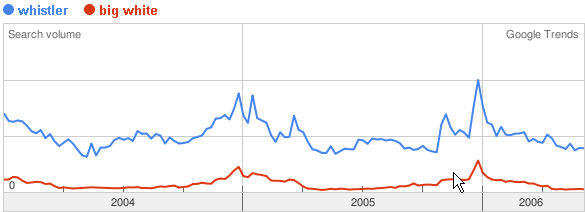
In Canada it’s a little different. The number of searches correlates to when it snows in Whistler. Last year, for example, the first snow fell in the last week of November and another big dump fell just before Christmas. Exactly when the searches for Whistler happen.United Kingdom
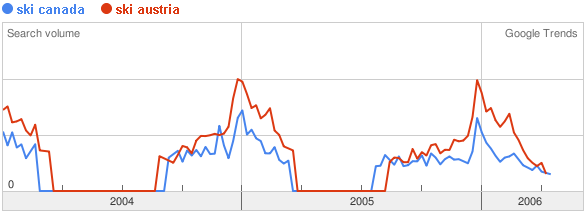
So what about a little further away? In the United Kingdom, I selected more generic keywords and it becomes very obvious when the Brits start planning a ski trip. They basically start in the fall, and it doesn’t matter if it’s for the Alps or Canada. I wonder if the big tour operators start their campaigns around that time, it could very well influence the time when online planning starts.Australia
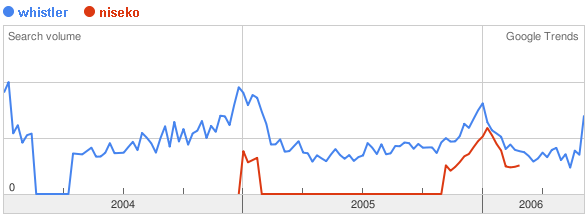
Skiing in Japan is hot with Australians at the moement. I used a popular Japanese resort to compare against Whistler. Based on what Google tells me, this seems to be correct that Australians are starting to favour Japan. Niseko came out of nowhere to compete with Whistler. It looks like the real planning in Australia doesn’t start until later then one would expect.As you see, Google Trends can be a valuable tool, in particular when you combine with other traditional research methods. I’m using it all the time and find it very useful.
-
Internet
Net neutrality, take action
The telco cartel wants to gut the Internet and portion it off to the companies that pay their broadband tolls. This is undermining every good about the internet. Today is a day of national protest in the US. For more info see SaveTheInternet.org, SaveAccess.org or watch the video below.
-
Internet
User Generated Content
05.04.06 | Permalink | 2 CommentsWho decides what’s true, what’s accurate, and what’s relevant information? This is what’s been on my mind lately. The reason is this thing called user generated content.
Wikipedia is probably one of the best examples of user generated content. Wikipedia is a fascinating website, an encyclopedia editable by anybody. You can find information about virtually everything, and you edit any article yourself.
There’s a lot of debate about accuracy and politics in Wikipedia. It’s all interesting but the end-user of the published material is the ultimate judge and right now Wikipedia receives 25 million visitors a month, making it the 18th most visited website on the internet. So obviously, a lot of people find it a useful resource. I use Wikipedia all the time, and I like it, but I wouldn’t use it for medical advice. Most people have a good ability to put information in context.
What’s more interesting to me is that Wikipedia proves that you can create a large amount of content in a very small period of time, using the collective power of many. When discussing user generated content, the focus is often on the risks of inaccuracy and abuse. But if users are able to put this in context, and Wikipeadia to a large degree proves that this collective way of content management can work, it opens a lot of doors.
Enter Wikitravel, a younger sibling of Wikipedia, dedicated to travel. It currently contains 8,743 destinations around the world. What role will Wikitravel play in the trip planning of the future? What role will Destination Marketing Organizations (such as Tourism BC) play on Wikitravel? Should we be editing BC content on Wikitravel? Will websites such as Wikitravel become as important to manage as regular media? Just one example of the impact of the rapid evolution of marketing tourism and I love it.
More to come about this subject.
-
Internet
Clubmonaco.com’s form over function
 Yesterday, my wife was in spring shopping mode and started surfing her favorite stores. One of them was Club Monaco. While I was watching The Apprentice, I heard noises of dissatisfaction coming from the couch. When I looked over my wife was performing something with my laptop as you can see on the picture (I asked her to re-enact the situation). Turns out she was trying to get a closer look at the clothes and literally put the screen an inch from her face to try and get a better idea. The picture was simply too small to make sense of. “I can’t see the colour, I don’t know the material, is it smooth or ribbed?” was the answer I got after I asked what was wrong with it. There was also no way to get the costs.
Yesterday, my wife was in spring shopping mode and started surfing her favorite stores. One of them was Club Monaco. While I was watching The Apprentice, I heard noises of dissatisfaction coming from the couch. When I looked over my wife was performing something with my laptop as you can see on the picture (I asked her to re-enact the situation). Turns out she was trying to get a closer look at the clothes and literally put the screen an inch from her face to try and get a better idea. The picture was simply too small to make sense of. “I can’t see the colour, I don’t know the material, is it smooth or ribbed?” was the answer I got after I asked what was wrong with it. There was also no way to get the costs.

So after, I went to the clubmonaco.com website to see what was going on. Turns out they have this section called “lookbook” [screenshot]. A section of the website that’s intended to get an idea of different combinations and accessories of the Spring collection (I think). You can flip through the “book” by clicking “next” and “previous”. It’s created in Flash and it’s very on brand. The design is nice and stylish, very Club Monaco.But as often the case, very on brand from a visual design perspective can be a terrible User Experience. Small photos, lack of information and no ability to further explore. My wife’s experience on the Club Monaco website was terrible, on brand or not. In fact, I think my wife’s perception of Club Monaco has changed for the worse. Definitely a bad “moment of truth”.
-
Internet
The Google Effect
Joshua Porter on the UIE blog writes about what he calls the Amazon effect. Whenever they test websites that sell stuff Amazon also sells, a user is inclined to just go to Amazon instead of using the site they’re called on to test.
I’ve seen the same effect during our usability testing. Sometimes, when we ask a user to look for a particular piece of tourism information on HelloBC.com, a user simply says “oh, let me just goto Google”, even though they are already on British Columbia’s official tourism website. We’ve been called that “the Google effect”.
In the late 90’s, the behaviour I observed was that users searched for a website they thought would contain the information they were looking for. These days, users search for the specific page on a website. They use more keywords, and more specific keywords in their search queries. They also often spend less time on a website trying to find the information if it’s not on the first page they land on. They’ll just go back to Google and try the next result.
So on HelloBC.com, we done a few thing to accommodate this behaviour. First, we’ve put a lot of effort against Search Engine Optimization. We’d like user to land on the page within our website that contains the information they’re looking for.
And second, we try to provide strong scent of information. So if a user isn’t on the exact page that contains the information, we like to present them with clear links to where the information is. A good example of this is our Sights, Activities and Events page.
-
Internet
Thank you Google
04.09.06 | Permalink | 4 CommentsWell, what do you know? Only a few days after I complained on my blog last week about not receiving an invitation to Google Analytics, guess what I found in my inbox…an invitation code! I’ve installed it on the MealMe.com website and so far it’s looking impressive. When I’ve had a few weeks of experience I’ll write a little review.
» Next Entries

